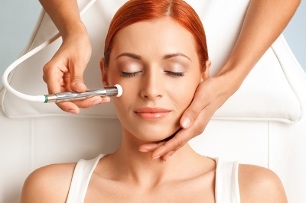
Laser facial rejuvenation involves non-surgical techniques and helps people who want to get rid of age-related skin changes. Modern cosmetology offers a variety of laser-based procedures that are a great alternative to plastic surgery.
What is this method?
The laser method means restoring the skin's youth in a very short time. The procedure uses a special device that emits rays of different intensities. The efficiency of the technique is very high, so a positive result is visible immediately. Laser skin resurfacing is a rather expensive and laborious procedure.
The number of procedures and the duration of the session are chosen individually by the doctor. The standard procedure consists of 5 sessions with a break per month. This approach can have a small effect on the skin. The procedure has a cumulative effect, as the natural processes of collagen and elastin production are revived in the inner layers of the skin after one session. Fractional skin rejuvenation can improve its condition. As a result, it becomes more flexible and dense.
The cost of the procedure is affected by:
- laser quality;
- number of areas to cultivate;
- The price of the care products that are applied during the session;
- Beauty Salon Reputation and Beautician Qualification.
Performing laser restoration
Laser restoration is performed only on clean skin. The procedure consists of a partial laser operation. The surface of the special device contains photocells, which are responsible for the penetration of the laser under the skin.
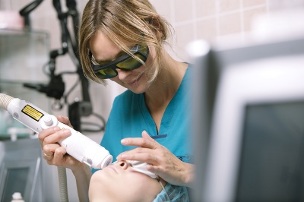
As a result of the action of the laser, cells are awakened by the heat current, and those that are unable to function die. Healthy cells replace dead cells, increasing the level of elastin and collagen in the skin. This causes minor damage to the epidermis.
A special device expels over the skin very quickly, a delay of only a minute will lead to severe burns. It can be used to treat entire facial skin or individual areas.
After laser facial rejuvenation, it becomes noticeable as follows:
- improved skin color;
- The face oval is drawn;
- bags under the eyes are missing;
- Small and medium wrinkles are less visible.
The big plus of this facial rejuvenation method is that there are no characteristic transition points between the regenerated dermis, no tuberculosis and swelling in the outer layer of the skin. Due to this fact, externally, the recovery process is almost imperceptible.
The laser reconstruction method can also be used to improve the results of laser reconstruction and plastic surgery. After completing the procedure, the face is treated with a special emollient solution.
After laser skin rejuvenation, cosmetologists recommend several important rules for several days:
- Avoid sun exposure.
- Do not use makeup.
- Do not go to the solarium and the beach.
- Do not expose your face to strong wind, chlorinated or salt water.
Advantages of the laser method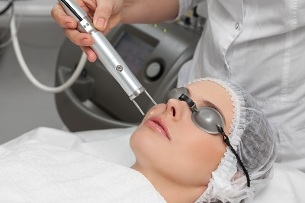
This facial rejuvenation method allows you to treat large areas of skin in one procedure, while its rejuvenating resource is preserved and revitalized. As a result, rehabilitation begins quickly and an increase in long-term positive effects is observed.
Fractional laser restoration is performed with a point effect, so the epidermis is minimally damaged. Footprints disappear within 3-4 days. No anesthesia required.
Side effects are rare. In some cases there are:
- Itching that disappears in a short time;
- temporary red spots;
- activates the effects of herpes;
- skin peeling and burns;
- crust.
You must complete 4 to 8 sessions to get a full recovery. How many procedures you need to do depends on the age and condition of your skin. This question can be answered by a qualified beautician. There should be a break of 2-3 weeks between procedures.
Indications and Contraindications
As with any cosmetic procedure, there are indications and contraindications for laser rejuvenation.
Fractional Face Recovery helps prevent:
- deep and fine wrinkles;
- spider veins;
- age spots;
- scar;
- pimples.
In addition, laser procedures are designed for porous skin, uneven relief and reduction of tissue tone. The skin will get an even and even tone.
There are contraindications to laser facial rejuvenation. They should not be neglected, otherwise serious consequences may occur.
It is forbidden to conduct sessions for pregnant and breastfeeding women, as well as for people who suffer from:
- severe chronic illness;
- Diabetes;
- low and high blood pressure;
- mental disorder;
- allergic diseases;
- Hypersensitivity to the skin.
Types of laser restoration
There are 2 types of laser restoration that differ in the method and depth of exposure: The first facial laser restoration method is a procedure that removes superficial microscopic areas of the skin. In this case, the penetration of the laser beam is performed to a depth of 1. 5 mm, obtaining:
- skin starts to tighten;
- activates recovery processes;
- skin is improved and smoothed.
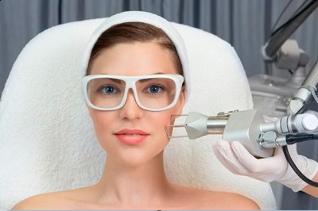
A positive result is displayed immediately. This method is used to lift the face, gives the skin an ideal look, eliminates skin irregularities, such as during acne treatment.
This procedure is great for correcting exact imperfections, such as:
- mimic wrinkles;
- scars;
- pigmentation and others.
The second method of laser restoration is the penetration of the laser beam into the deepest layers of the skin - about 3-5 mm. In this case, the face is exposed to long laser beams. The upper layers of the epidermis are not affected, the restoration is done from the inside.
This facial skin fractional rejuvenation helps restore deep skin layers. It promotes the activation of metabolic processes, as well as is necessary for the formation of a more durable collagen structure. This causes an increase in skin firmness and elasticity
This procedure is quite serious. It is prescribed for very deep scars, severe rashes and if the face is damaged by chemicals. The main advantage of this method is the absence of a complete recovery period. This differs from ablative in that the entire surface of the face is treated at once.
Experts recommend performing these 2 types of facial laser rejuvenation at the same time to achieve the greatest effect and maximize tissue regeneration processes.
4D Restore
Laser 4D restoration is one of the safest ways to remove blemishes and tighten. This method takes place in 4 stages. The skin is exposed to a neodymium laser. The beautician processes the facial tissue in the order of the inside and outside of the cheeks. The work is performed in different modes, intensifying each other's operation.
- The first step is lifting from the inside of the cheeks, the area around the nose and lips. The device has a special device that is inserted into the oral cavity. The folds in the lips and nose are pushed out and visually smoothed. The laser beam affects the deeper layers, causing the production of collagen. As a result, the structure of the deep layers is tightened.
- In the second stage, there is a complete restoration of the skin's structure, which manifests itself in the smoothing of wrinkles, tone, elasticity and the formation of constricted pores.
- The third stage helps to restore all layers of the skin: deep, medium and superficial. The biorevitalizing effect is provided to the tissues because they receive a lot of heat completely painlessly.
- The fourth stage is based on cold peeling technology, during which the skin surface is sanded. The beautician removes the epidermal stratum corneum. As a result, 4D facial rejuvenation creates radiant skin. This result can be achieved in 1 session. All 4 steps are performed during 1 procedure without interruption, one after the other.
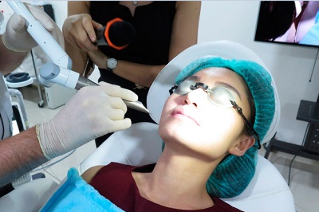
The method has certain advantages. One of the most important benefits is the painlessness of the procedure. The painless laser effect does not damage the gums, teeth and oral mucosa.
Other positives are:
- effectiveness;
- fast and lasting result;
- small recovery period;
- Ability to perform the procedure at any time of the year.
DOT Recovery Innovation
DOT rejuvenation is a new modern cosmetological method using the latest technologies. This procedure is very effective, it is performed in advanced cosmetology centers and plastic surgery clinics. This system is a versatile remedy for the problems caused by skin aging due to the natural biodegradation of muscles and connective tissue.
A special laser with a specific wavelength is applied to the skin with the help of laser DOT.
Fractional laser beam radiation in the deep layers of the skin occurs:
- Lymph and blood flow restoration;
- increases elastin and collagen production;
- Improving connective tissue regeneration;
- Increased skin turgor;
- Resorption of age spots, vascular networks and nodules.
During DOT restoration, the device gently affects the skin, which means that you can perform an eyelid, neck and décolleté restoration procedure. The intensity of the sensations during the session depends on the sensitivity of the skin, the pain threshold and the strength of the device's sensors. To make the patient comfortable during restorative manipulations, it is proposed to use 1 of the local anesthetic methods in the place where it is planned to operate with a laser.
The DOT procedure gradually gives a positive result. At first, the patient is unable to assess the consequences because there is swelling and redness of the skin. Only after 14 days will the optimal effect be seen.
Neodymium facial reconstruction method
The neodymium laser restoration method is a new, very effective method. During manipulation, thermal energy is transmitted to the skin by a neodymium laser, which begins to affect the collagen fibers. This causes them to tighten the skin shell, initiating regeneration and rejuvenation processes.
As a result of the procedure it is possible to:
- improves skin condition;
- Refreshes color and corrects face contour;
- reduces, evens out fine lines, vascular formations and age spots;
- improves skin firmness and density.
The neodymium facial regeneration method lasts for at least 12 months. Its effectiveness can be increased if peeling is performed before the procedure. This approach will help the laser beams come into better and deep contact with the skin structure.
















































































